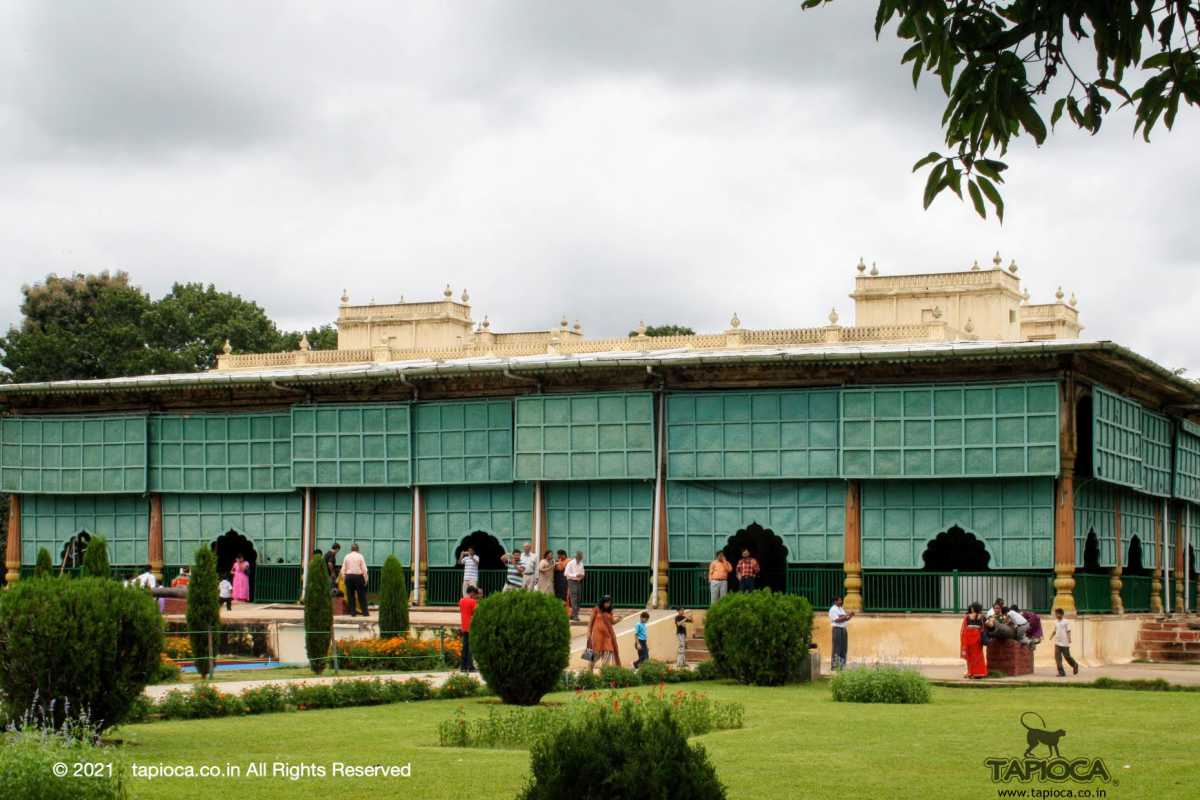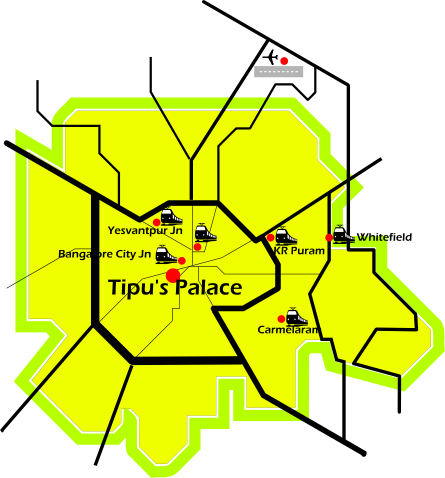Tipu Sultan's Palace
Haider Ali, Tipu Sultan's father, started the construction and Tipu Sultan completed in 1791.
Tipu Sultan's Palace in Bangalore is an important monument both from a historic and touristic point. For a palace, it is a compact structure. Yet it is impressive for its details and the layout.
F
rom outside the palace complex looks like another compound in an otherwise busy part of the Bangalore city. To really know its original stature, you need to understand how Bangalore looked some 300 years back.A huge fortification went around the city. Almost every important structures of Bangalore city were inside the this long fort wall. And that was the Bangalore Fort . This summer palace of Tipu Sultan stood inside the citadel.
. This summer palace of Tipu Sultan stood inside the citadel.
All you can see as the remain of the Bangalore Fort is the so called Delhi Gate, a short walk towards south on the Krishnarajendra Road. This palace is actually located close to the point where the fort was breached in 1791 during the 3rd Mysore War.
The city grown gradually and engulfed the whole citadel, leaving only a handful of the Tipu era landmarks as a remainder of its legendary past. The Tipu Sultan's summer palace is prominent among them.
The palace was adoringly called in Urdu Rashk É Jannat (envy of the heaven), thanks to its great atmospherics. After the fall of Mysore the palace lost its significance as a royal structure. Later during the colonial period, this structure was serving as an administrative office (1831-1868) of the British Raj, before moving it to the Attara Kacheri ( the present day High Court building).
The palace is now under the maintenance of the Archeological Survey of India.
The most interesting part of the summer palace in Bangalore is the open architecture with beautiful porches and elegant halls. Those woodwork with the cusped arches and the grid of pillars makes it majestic. There is ample space for a formal gatherings.
The main attraction of the palace is the central hall on the first floor. Four stairways at the four corners give access to the two porches on either ends of the hall. On either sides of the open hall are rows of paired columns. Right at the middle of the hall are two protruding balconies overlooking the porch in the front and rear of the palace.The balconies are popular spot among tourists to pose for a phonograph! Otherwise it would have been used as a platform for some kind of Public Audience. While the balustrades of the balconies looks simple , the supporting brackets below it ( the corbels seen from the ground floor ) shows some fine woodwork.
The general orientation of the hall and the open nature makes the hall naturally illuminated throughout the day. Still the hall appears a relatively secluded thanks to the sloping eaves on the roof of the palace and also being on the first floor.
The next most interesting parts are the canopy like eaves in the front and rear of the palace.There are giant corbels supporting the rafters, both carved of wood.
The carving on the corbel looks a lot Hindu style ,while the design of the palace is generally done with a flavor of Islamic style architecture. So are the floral patterns and motifs on the walls and ceilings. Images of such forms are not seen in the typical Islamic school of architecture.
The central portion of the ground floor is now converted into a small museum. Unlike the open pillared hall just above it, the now museum portion of the palace is a closed hall. The inner walls are decorated with the typical floral frescos. The decorations on the outer wall of this hall is either lost(most likely) are were not simply there. Now it appears with a brick red painting, that definitely adds some warmth and that old world charm to the interior of the palace.
Back to the museum.You can see a number of historical portraits of Tipu sultan is on display. So are the narrations on the history in general.
After visiting the museum you would take one of the two stairs to reach the central hall located just above the museum portion. From this vantage point you can see the panorama of the palace interior in 360 degrees.
The roof and the ceilings are supported by massive teakwood columns.Thanks to their numbers and the style, these carved wooden pillars together with cusped arches between them defines the character of the whole interior.
The pillars are monolithic tall wooden blocks (trunks of the tree ) cut, shaped and decorated for the purpose. The most attractive parts of the pillar are the base and the capital. The carving on the base appears as if the pillar is emerging out of a flower and end with a matching capital with petals carved on it. The capital and the base are painted in pale yellow or golden hue, while the pillar as such appears in a darker maroon. Another interesting feature of the pillar is its fluted design along the length. That with its textured surface appear as if the pillars are carved out of some kind of stone.
While the squarish end of the capital supports giant beams, the base of the pillar sits on elegantly dressed granite plinths. Probably it is installed on to the sockets of these plinths. In most cases the pillars appears as a pair - that is two pillars stands very close to each other - for added structural strength and aesthetics.
The pillars at the front and rear halls are almost double the height of the ones in the central part of the palace. That's because the front and rear halls are two stories high with the first floor located in the central part of the palace.
The facade of the palace is in fact on the western side of the palace. You will not realize it till you reach this part of the palace.However this part of the palace is now functioning as the archeology offices. The rear part of the palace is pretty plain with a giant wall.
On the northern and eastern side are the typical ASI garden comprises of a sprawling lawn and paved passages across it. Another interesting feature you notice while at Tipu's Palace is the adjacent Kote Venkataramana Swamy temple. The temple is in fact located at the northeastern quarter of the palace compound, but separated by a compound wall. However from the palace compound you can see closely the elaborately decorated towers and the gateway of Kote Venkataramana Swamy temple. The entrance to the temple is on the around the corner of the road. It is a charming sight the pale yellow painted Dravidian style towers projecting over the creeper grown compound wall of the palace. The temple is some 300 years old.
 How to reach Tipu's Palace:
How to reach Tipu's Palace:
Tipu's Palace is located a few blocks south of the K R Market. Get to the signal of Bangalore Medical College on the Krishna Rajendra Road. From the signal turn into Albert Victor Road. You can see the tower of the Venkataramana Swamy temple at the junction, as you approach the signal. The palace is located right behind the temple.
From Tipu's palace you can easily reach the Bangalore Fort too. It's at a 5 minutes walk towards K R Market.
 Tipu's Palace Entry Timings :
Tipu's Palace Entry Timings :
Palace is open for visitors from 8.30 AM to 5.30PM everyday. You'll need about 1 hour to tour the palace.
 Tipu's Palace Entry Fees :
Tipu's Palace Entry Fees :
Admission fee is Rs 5 for citizens of India, SAARC and BIMSTEC ( Afghanistan, Bangladesh, Bhutan ,India ,Maldives, Myanmar, Nepal, Pakistan, Sri Lanka , Thailand ). For other visitors the fee is Rs 100.
Children under 15 are admitted free. Usage of still camera is free. For Video camera, fee is Rs25.
Ticket counter is located near the main gate facing the road.

Mysore
Tipu sultan's summer palace in Srirangapatna
 Tipu’s Palace is located a few blocks south of the K R Market. Get to the signal of Bangalore Medical College on the Krishna Rajendra Road. From the signal turn into Albert Victor Road. You can see the tower of the Venkataramana Swamy temple at the junction, as you approach the signal.">
Tipu’s Palace is located a few blocks south of the K R Market. Get to the signal of Bangalore Medical College on the Krishna Rajendra Road. From the signal turn into Albert Victor Road. You can see the tower of the Venkataramana Swamy temple at the junction, as you approach the signal.">
Tipu's Palace is located in the city center, south of the KR Market. This is about 2km south of Majestic and 5-10 minutes walk south of KR Market.
Tipu’s Palace is located a few blocks south of the K R Market. Get to the signal of Bangalore Medical College on the Krishna Rajendra Road. From the signal turn into Albert Victor Road. You can see the tower of the Venkataramana Swamy temple at the junction, as you approach the signal.
Soapstone sculptures
The beauty of the Hoysala templs , particularly its intricate carvings owes a lot to one material - Soapstone. Unlike granite, sandstone and marble used in the construction of most of India's ancient monuments, soapstone is softer with some peculiar properties that set it apar from the former materials. To give you an idea , the softer version of the soapstone can be carved even with your finger nail.
